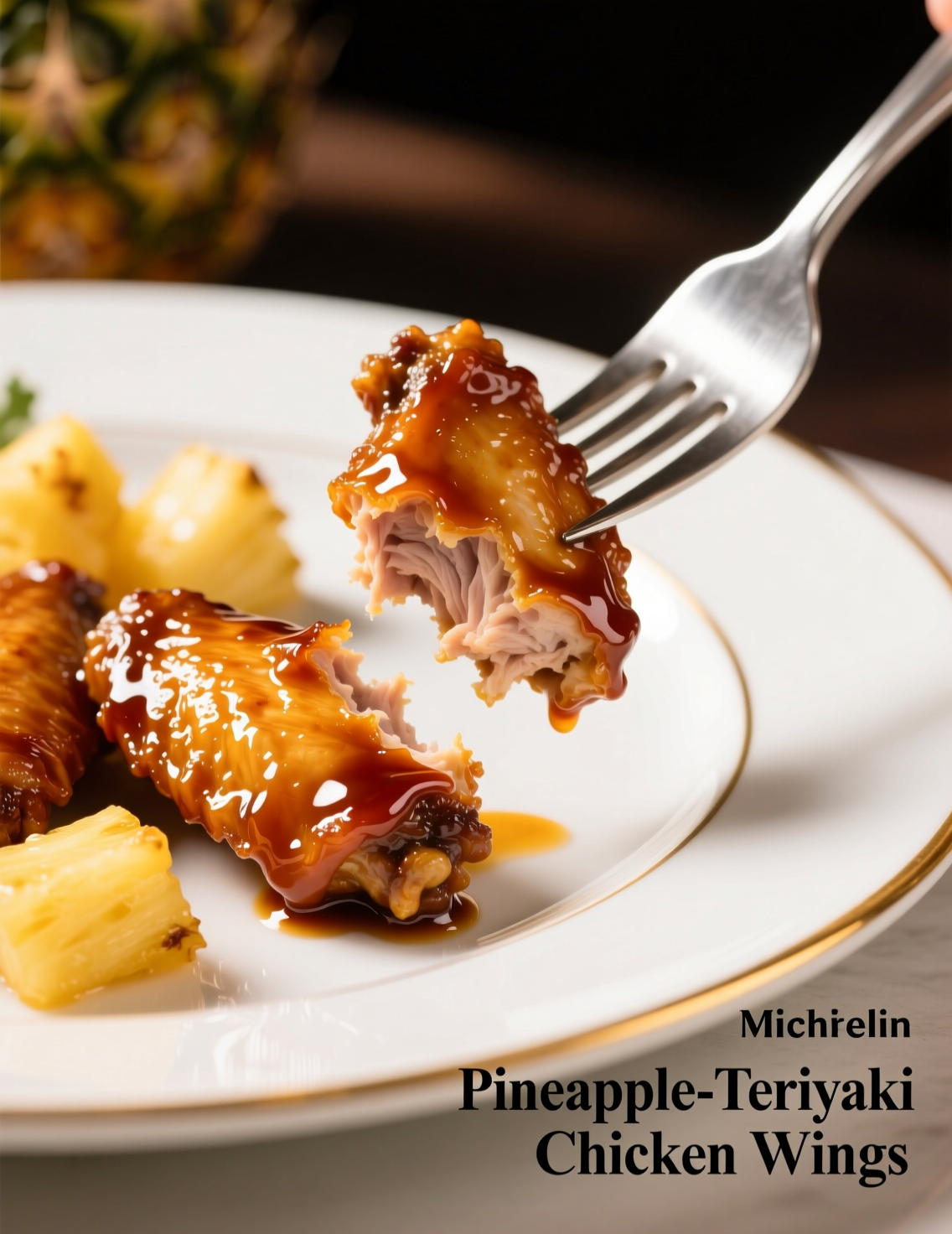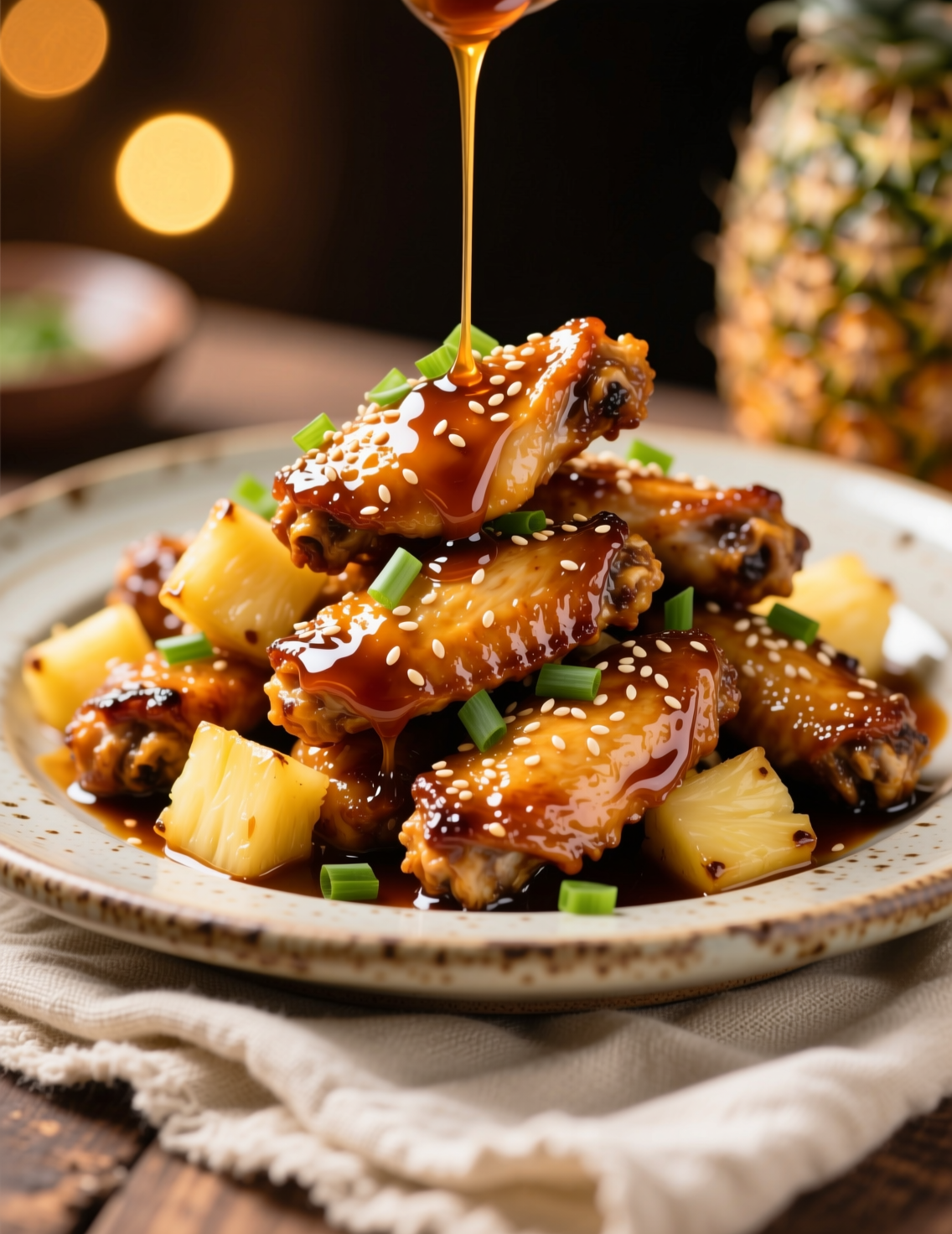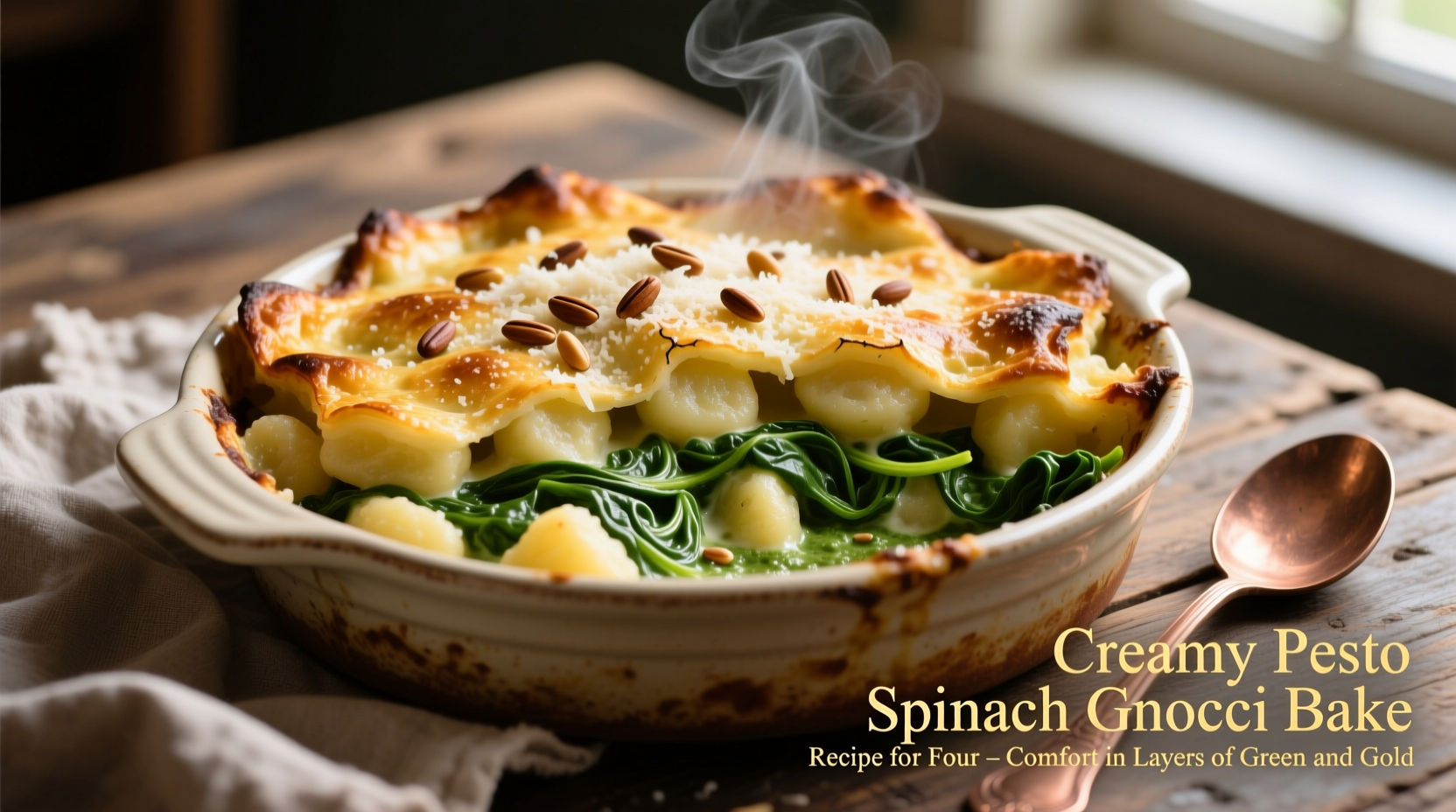There are dishes that simply sit on a plate, and then there are dishes that sing. Pineapple-Teriyaki chicken wings belong to the latter. They don’t just feed hunger; they build a memory. The sweetness of pineapple, the sticky sheen of teriyaki, and the irresistible crisp of chicken wings collide in one bite that you don’t just taste, you remember. Today, I’ll show you not just how to make them, but why they work and what separates a great version from the average one.
Why Pineapple and Teriyaki Belong Together
Pineapple isn’t just about sweetness. It’s got a natural acidity that sneaks into proteins and makes them more tender. Teriyaki, with its soy backbone, balances saltiness and umami. When the two are brought together, it’s not random fusion—it’s chemistry.
Hawaiian and Japanese cuisines have been mingling for decades, especially since the plantation era when pineapple became a symbol of the islands. Chefs recognized pineapple’s power early on. Its bromelain enzyme literally breaks down collagen in meats, softening them without losing structure. Wings, being collagen-rich, are perfect candidates.
Now pair that tender bite with a glaze that’s glossy, sweet-savory, and clings to your fingers. You’ll see why chefs in gastropubs and Michelin-star kitchens alike keep reinventing this duo.
The Anatomy of the Perfect Chicken Wing
Before we even toss in sauces or start heating pans, wings demand respect. A wing isn’t just a random cut. It’s three parts: the drumette, the flat, and the tip. Each behaves differently under heat. Drumettes mimic tiny drumsticks, meatier with a single bone. Flats have two bones and carry a balanced ratio of skin-to-meat, meaning better crisp if handled right.
Professionals don’t ignore these differences. A chef will separate them, season them separately if needed, and ensure cooking methods honor both cuts. For this recipe, separating them before cooking ensures even crisping and proper sauce coverage.

Ingredients: More Than Just a List
For four servings (roughly 16–20 wings depending on size), here’s what you’ll need. But don’t just skim—let me unpack why each matters.
- Chicken wings, 2 pounds – Always fresh, never frozen if you want skin to blister correctly.
- Pineapple juice, 1 cup – Fresh squeezed if possible. Canned is fine but avoid concentrate, it’s too sweet.
- Soy sauce, ½ cup – Go for naturally brewed, low-sodium keeps balance.
- Brown sugar, ¼ cup – Adds depth, molasses notes stick to the glaze.
- Garlic, 3 cloves minced – Roasted garlic works too if you want sweetness over bite.
- Ginger, 1 tablespoon grated – Don’t substitute powdered, fresh has oils you need.
- Rice vinegar, 1 tablespoon – Cuts through sugar and pineapple sweetness.
- Sesame oil, 1 teaspoon – A drop too much overwhelms, restraint is key.
- Cornstarch slurry (1 tbsp cornstarch + 2 tbsp water) – Thickens glaze without muting flavors.
- Pineapple chunks, ½ cup – Lightly charred for contrast, not optional if you want wow factor.
- Scallions, sliced – Fresh garnish, sharpens final profile.
- Sesame seeds, toasted – Texture and nutty finish.
A seasoned cook looks at that list and doesn’t just see “ingredients.” They see levers. Sweetness, acidity, umami, texture—all in a controlled orchestra.
Step One: Prepping the Wings
Pat them dry like you mean it. Damp skin equals steamed chicken, and steamed chicken is sadness on a plate. Professionals will even let wings sit uncovered in the fridge for an hour or two, allowing the skin to dry further. It’s a technique called pellicle formation. Smokehouses use it, but it works wonders for crisp oven-baked or fried wings too.
Season them simply with salt and pepper. That’s it. Nothing fancy yet. Let the sauce do the heavy lifting later.
Step Two: Cooking Method Choices
Here’s where opinions split kitchens. Frying gives undeniable crispness, but oven-baking with convection or air frying delivers nearly the same result with less oil mess. For 2 pounds, bake at 425°F for 40–45 minutes, flipping halfway. Frying? Heat oil to 350°F and fry for 8–10 minutes until golden.
Air frying has become a trend in pro kitchens, not just homes. Data from the National Restaurant Association in 2023 showed a 20% increase in restaurants testing air fryer stations for healthier menus. It’s not a gimmick—it’s efficiency. Faster cook times, reduced oil costs, consistent results.
Step Three: Building the Sauce
Sauce isn’t an afterthought. It’s architecture. Combine pineapple juice, soy, brown sugar, garlic, ginger, rice vinegar, and sesame oil in a saucepan. Bring to a simmer, stir occasionally. Don’t rush it—let it reduce by about a third. This concentrates flavors, thickens naturally before the cornstarch slurry even comes in.
Add the slurry slowly, whisking as you go. Overdo it, and you’ll end up with pudding instead of glaze. When done right, the sauce should coat the back of a spoon, glistening like lacquer.
Now toss in charred pineapple chunks. This step matters. Fresh pineapple grilled or charred releases caramelized sugars that make the sauce sing louder. Raw chunks taste flat in comparison.

Step Four: Marrying Wings and Sauce
This is where amateurs go wrong. They either drown wings until they’re soggy or drizzle sauce so lightly it barely registers. The key is tossing in a large stainless bowl, wings still hot from cooking. Hot wings pull sauce in; cold wings repel it. Professionals know to sauce immediately, no delay.
Every wing should come out glossy, sticky, and evenly coated. That sheen isn’t just cosmetic—it signals the glaze has bonded to fat and protein surfaces.
Garnish Like You Mean It
Scatter scallions and toasted sesame seeds just before serving. This isn’t “just for looks.” Scallions add sharpness, sesame seeds add crunch. Both break the monotony of sweet-sticky wings, giving layers your palate can reset with.
Flavor Dynamics and Why They Work
Professionals break down flavor into categories. Pineapple gives fructose sweetness and tart malic acid. Teriyaki base brings glutamate-rich umami from soy. Garlic and ginger add sulfur and spicy aromatics. Vinegar balances pH, preventing cloying sweetness. Sesame oil and seeds bring fatty roundness.
This layering is deliberate. Humans taste balance. Too much sugar? Flat. Too much salt? Harsh. Get the pyramid right, and you create craveability—a food industry term for dishes people can’t stop eating. Chains like Buffalo Wild Wings study this balance meticulously in test kitchens.
Common Pitfalls to Avoid
One mistake: adding pineapple juice too early in the sauce and cooking it on high heat. Bromelain enzymes can turn bitter if overheated. Keep the simmer gentle.
Another error: crowding wings on a pan. Crowding equals steaming, not crisping. Always give them breathing room.
Finally, don’t store wings already sauced if you expect leftovers. They’ll sog. Keep sauce separate and toss only when reheating.
Professional Tweaks
Chefs often layer flavors further. For instance, using a splash of mirin in the sauce deepens sweetness naturally. Others might brine wings overnight in a pineapple-soy mixture for extra tenderness. Smoked wings finished with pineapple-teriyaki glaze? That’s next-level, and barbecue competitions love this trick.
You could even dehydrate pineapple slices, grind them into a powder, and dust over finished wings for a tangy accent. Small details like this turn a home recipe into a menu standout.
Emerging Trends: Global Fusion
Globally, pineapple-teriyaki wings fit the rising demand for Asian-inspired flavors. According to a 2024 Mintel report, 39% of US consumers actively seek “sweet and savory fusion” flavors in snacks and appetizers. Pineapple-teriyaki fits perfectly into that trend, explaining why it’s popping up in food trucks and upscale cocktail bars alike.
Restaurants are even pairing wings with pineapple-based cocktails—think rum punch or grilled pineapple margaritas—to amplify the theme. This cross-utilization boosts both food and beverage sales.
Nutrition and Considerations
Each serving of four to five wings clocks in around 300–350 calories, depending on cooking method. Baking saves about 50–80 calories per serving compared to frying. Pineapple juice contributes natural sugars, but balance it with protein-rich chicken and you have a dish that satisfies without wrecking a diet.
Conclusion: Wings That Speak a Universal Language
Pineapple-teriyaki chicken wings aren’t just party food. They’re a study in balance, technique, and culinary storytelling. You take a cut often dismissed as bar fare and elevate it through chemistry, cultural history, and precise execution.
For professionals, the lesson is clear: never underestimate the power of pairing ingredients across borders. For home cooks, it’s simpler—make these wings once, and you’ll understand why sweet, savory, sticky foods rarely leave the table with leftovers.
Serve them hot, glossy, with charred pineapple by the side, and watch how silence falls at the first bite. That’s the sound of a recipe that worked.
FAQs
How many servings does this pineapple-teriyaki chicken wings recipe make?
It makes 4 servings, usually about 16–20 wings depending on size.
Can I use canned pineapple juice instead of fresh?
Yes, but avoid concentrate since it’s overly sweet and less balanced.
What’s the best cooking method for the wings?
Baking, frying, or air frying all work, but frying gives maximum crispness.
Should I sauce the wings before or after cooking?
Always toss them in sauce right after cooking while still hot.
How do I keep the wings from getting soggy?
Don’t overcrowd the pan, and sauce only when ready to serve.
Can I make the sauce ahead of time?
Yes, the teriyaki sauce can be made 2–3 days in advance and refrigerated.
Is sesame oil necessary in the recipe?
Just a teaspoon adds depth, but too much will overpower the glaze.
Can I grill the pineapple instead of charring in a pan?
Absolutely, grilling caramelizes the sugars and adds smoky complexity.
Are these wings healthy?
They’re lighter if baked or air-fried, averaging 300–350 calories per serving.
How should leftovers be stored?
Keep sauce and wings separate in the fridge and toss together when reheating.

Mariana is a passionate home cook who creates delicious, easy-to-follow recipes for busy people. From energizing breakfasts to satisfying dinners and indulgent desserts, her dishes are designed to fuel both your body and hustle.
When she’s not in the kitchen, she’s exploring new flavors and dreaming up her next recipe to share with the Foodie Hustle community.

